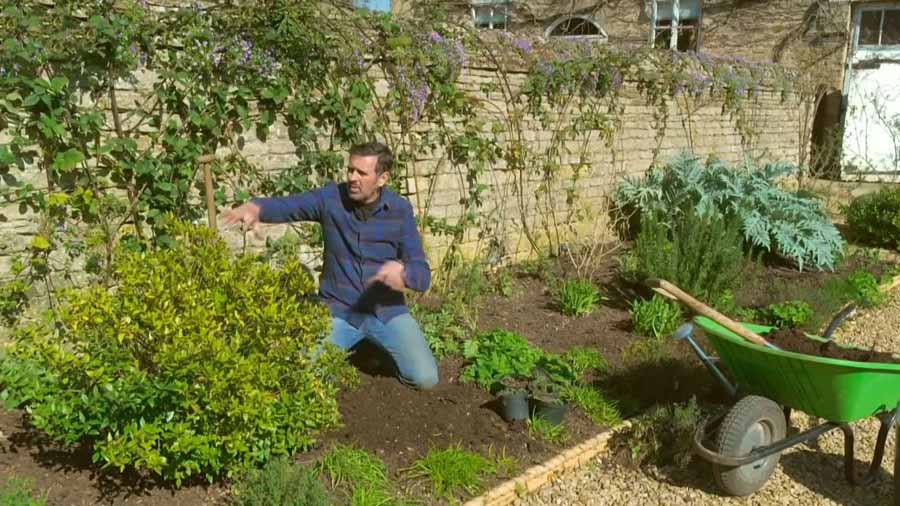Gardeners World episode 13 2020: At Longmeadow, Monty plants out tender vegetables for late summer harvests and gives tips on plants that thrive on a minimum of water when he plants up a pot of succulent plants.
Frances Tophill demonstrates an unusual method of reducing weeds in her allotment. Gardeners World team meet a gardener in Wales who has dedicated years to breeding some very special varieties of rhododendrons. Joe Swift is in Devon finding out about the design and planting challenges faced when creating a coastal garden, and in Staffordshire, a gardener has filled every inch of his garden with spectacular plants. And more viewers have their own gardening tips to share.
Gardeners World episode 13 2020
Deadheading plants
Deadheading is the term used for the removal of flowers from plants when they are fading or dead. It is done to keep plants looking attractive and encourage more blooms, whether in beds and border, containers or hanging baskets.
Remove the spent flowers as soon as they look scruffy. In practice, gardeners usually have to remove them as soon as they can and, thankfully, a few days delay won’t make a difference. The simplest method is to just pinch off the faded blooms with finger and thumb. Aim to remove the flower with its stalk to ensure the plant looks tidy.
Rhododendrons on alkaline soils
Rhododendrons grow best in soils with a pH of 4.5-6.0. They do not grow well in soils with appreciable levels of calcium. This is principally due to iron getting ‘locked up’ and becoming unavailable to the plant. Soil pH is easily measured using a home soil test kit available from garden centres. Alternatively, the RHS provides a comprehensive soil analysis service.
Generally, it is difficult to alter soil pH in the long term. A high level of organic matter in the soil is advantageous, particularly an acid medium such as peat substitute, chopped bracken or decayed pine needles but this alone will not bring about any appreciable reduction in soil pH.
With neutral or slightly alkaline soils chelated iron can be used. Ericaceous compost, chopped bracken and pine needles at planting, plus a dressing of sulphur, may also enable rhododendrons to be grown. Aluminium sulphate (found in hydrangea ‘blueing’ agents) should not be used to acidify soils where rhododendrons are to be grown.
Cabbages
Cabbages come in different shapes, sizes and colours, and with a little planning it’s possible to pick them fresh nearly every day of the year. They can be used raw in salad or coleslaw, and as ingredients in soup, boiled, steamed or braised. Different types can be harvested throughout the year.
Cabbages need a sunny site and firm soil. Wherever possible, prepare the soil in autumn by adding well-rotted manure or garden compost and then leave it over winter to consolidate. Before planting cabbages, make sure the soil is well firmed by shuffling along the surface on your heels, then rake it flat. You should not grow cabbages in the same soil that you grew them (or other brassicas) the previous year.
Cabbages are best suited for growing in the open ground, but you could grow one or two in large, deep containers. They are not suitable for growing bags. Cabbages can be either sown directly in the ground outside, or in seed trays (and left outdoors). If you only want a few cabbages, it is best to sow in seed trays, then transplant outdoors. Use modular trays, and sow one seed per module.

Plants for coastal areas
Strong, often salt-laden winds present a challenge for planting in coastal gardens. Providing windbreaks in the form of hedges or netting will widen the range of plants that can be grown. To establish plants successfully in exposed situations it is essential to form a windbreak or shelter belt against the prevailing coastal wind. It is best to develop a wind-filtering screen of trees or shrubs, but polypropylene webbing or woven hurdles of willow or hazel are alternatives.
It is not advisable to use solid structures such as walls or fences, as these can create turbulence and add to the problems. A windbreak can reduce wind on its leeward side for a distance of ten times its height. Once a barrier has been established, it may be possible to grow quite a wide range of coastal-tolerant plants.
Citrus – Gardeners World episode 13 2020
Citrus are not hardy in Britain but can be grown in pots outdoors in summer and brought inside for winter. Of all citrus, most gardeners grow lemons; kumquats are the most cold tolerant; others, like limes and grapefruits, need more warmth. The fragrant flowers can appear all year round, but are especially abundant in late winter. Fruit ripens up to 12 months later, so they often flower and fruit at the same time.
Citrus in pots can be put outdoors in summer, in a sheltered sunny position, but only when temperatures increase, from mid-June until late September. Keep some fleece handy in case of sudden cold nights in early summer. Low temperatures will inhibit flowering and may cause damage or even death.





Dearest Celebrities,
Your gardens look idyllic and perfect. But that is not a reality in our gardens. We have aphids infestations, vine weevil, slug and snail devastation. Have you not got any of these? All your gardens are picture perfect and l am just a frustrated beginner Gardner. Kind of put off as well. I feell like seeding grass everywhere next year 😦